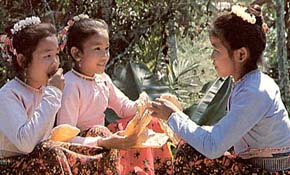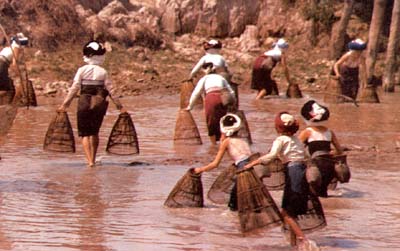

|
Xishuang Banna is the southernmost part of Yunnan bordering Laos and Myanmar. The Dai are the predominate nationality here. This area has a subtropical climate similar to northern Thailand. The vegetation and wildlife are typical of southeast Asia. There are wild elephants still roaming here and a variety of flowering plants not seen in the more temperate parts of Yunnan. Buddhism is very strong and there are many saffron robed monks and beautiful temples. To celebrate the Dai New Year, usually in April, the Dai have the "Water Splashing Festival." Traditionally a small dab of water was placed on the guest's back as a special greeting but now the small dab has grown into several liters of cold water poured over the head or thrown at passersby.
|

|
Manfeilong PagodaManfeilong Pagoda was built in 1204. Its main tower is over 20 meters tall. In Xipshuang Banna Theravada Buddhism is practiced by many. Every village has its temple, some dating back hundreds of years. Almost every Dai boy will go to the temple beginning at age six or seven and stay there two or three years to begin his education and learn the precepts of Theravada Buddhism. The monks give lectures on Buddhist scriptures and perform ksama, a type of confession. Early each morning the monks leave the temple with their "begging bowls" in hand and make their morning rounds to collect food for those staying at the temple. Many men return to the temple and the monastic life several times during their lives for a period of meditation and spiritual revival. Back to: Top |
|
Dai FisherwomenThere are many waterways in Xishuang Banna and much of life depends on these for food, transportation and sanitation. In this photo Dai women are returning from a fishing excursion. Bamboo traps are placed to catch the fish, these work in much the same way as a dip net might be used. In the Dai culture most of the work relating to the production of food is performed by women. Back to: Top |
 |
Rice PaddiesXishuang Banna is the wet rice basket of Yunnan. The climate is such that two or three crops can be grown each year. The soil is rich and havests abundant. Agriculture in this area dates back over 2000 years. Even today agriculture is the primary industry of the area and most families have their own land to till. Since the Liberation rice production has soared from 60 million kg. in 1949 to 230 million kg. in 1990. Other industries to be found here are chemical, fertilizer, sugar and rubber production.
Back to: Top Return to: Tourism Page
|  |